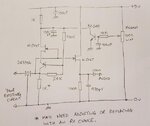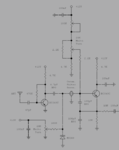neazoi
Advanced Member level 6
Hi,
I would like to replace the regenerative detector in this circuit **broken link removed** (the one at the end of the pace), with the attached one. This is in order to cover more bands without changing any other component other than the resonator.
I have built it and it works. However, I am not sure I extract the audio from the right place. This is because, when I adjust the regeneration too low (pot close to the gnd), the output audio attenuates.
I would like to replace the regenerative detector in this circuit **broken link removed** (the one at the end of the pace), with the attached one. This is in order to cover more bands without changing any other component other than the resonator.
I have built it and it works. However, I am not sure I extract the audio from the right place. This is because, when I adjust the regeneration too low (pot close to the gnd), the output audio attenuates.


